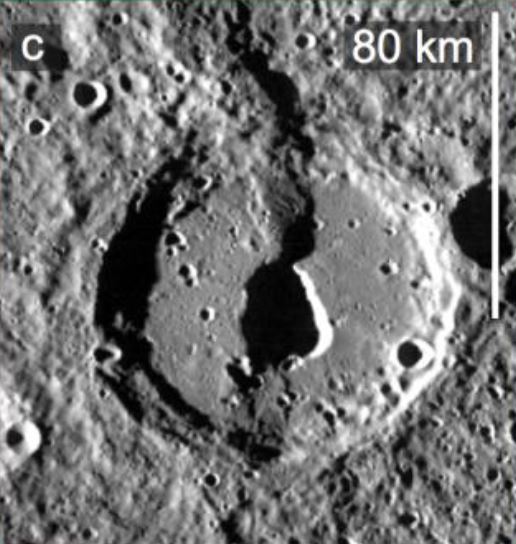18 April 2017
Mercury’s craters offer clues to planet’s contraction
Posted by larryohanlon
By Larry O’Hanlon

The Crater “Geddes” sliced by the Antonaidi Dosum fault. This is an example of a crater that predates the fault.
Mercury’s cratered surface, like the moon, tells a story of bombardment that goes back billions of years. Now scientists have used this history of impacts to determine when and at what rate Mercury cooled down after its formation and shrank to its present size.
The shrinking, or contraction, of the planet has been surmised ever since the Mariner 10 spacecraft beamed the first close-up images of Mercury’s surface to Earth in the 1970s. Those images showed thrust faults – faults that move vertically – cutting across the planet’s surface. These faults are most easily explained by the contraction of the whole planet as it lost heat and cooled over billions of years.
Now, a new study used images of Mercury’s craters to examine their degradation, which can be used to date the thrust faults. The new analysis, using images from the more recent Messenger spacecraft, suggests global contraction of the planet likely began more than 3.85 billion years ago, just after the “Late Heavy Bombardment” period, when all the planets of the inner solar system were being bombarded by material that had not formed planets. The slip rates of the thrust faults at that time were about 0.1 to 0.4 millimeters per (Earth) year (0.004 to 0.016 inches per year). Contraction of the planet gradually slowed from that time to the present day, according to the new research.
“If the faults are recording global contraction and craters are recording time and location, then a crater puts a time stamp on a fault,” said Kelsey Crane, a doctoral student at the University of Georgia in Athens, and lead author of the new study in Geophysical Research Letters, a journal published by the American Geophysical Union.
The new study could help scientists understand how Mercury evolved over time and how our solar system formed, said planetary scientist and Mercury researcher Steven Hauck, II, of Case Western University in Cleveland.
“The history of thrust faulting on Mercury is one of the biggest opportunities to understand how the planet has evolved over the past 4 billion years,” said Hauck, who was not involved in the new study. “By placing constraints on the timing – and especially the change in rate of contraction – [the authors] have placed potentially powerful constraints on how the planet has cooled.”
Shrinking Mercury
Since the first images of Mercury sent back by Mariner 10, and subsequent images from the Messenger spacecraft, scientists have sought to understand Mercury’s shrinking. In the new study, Crane and her graduate advisor Christian Klimczak, decided to see if they could date the faults caused by Mercury’s contraction by using the planet’s craters.
The craters serve as time-markers for the faults because they can be dated by how degraded they appear. The more degraded looking craters are older. Those that have sharper features are younger, and those with bright rays of debris radiating around them are youngest of all. This is the same approach taken by scientists to date craters on the moon, which has been confirmed with rock samples brought back by Apollo astronauts.
Crane and Klimczak looked at thousands of craters on Mercury – all of those between 20 and 2,000 kilometers (12 and 1,200 miles) in diameter – and determined their relationships with thrust faults. Their investigation used more than 6,000 faults, many of which had not been previously discovered.
All of Mercury’s thrust faults were not caused by global contraction, but their distribution suggests that most were, according to Crane.
The researchers found that the youngest craters were not sliced by faults. About one-half of the slightly older craters were cut by faults while even older craters were mostly scarred by faults. The oldest craters rarely landed atop faults, which suggests they were generated by impacts into a slightly larger Mercury before contraction of the planet had started.
This information allowed Crane and Klimczak to date when contraction started and stopped.
“That’s a record that thrust faulting had stopped in this spot on the planet,” Crane said.
— Larry O’Hanlon is a freelance science writer, editor and social media manager. He manages the AGU blogosphere. Follow him on Twitter at @earth2larryo










 GeoSpace is a blog on Earth and space science, managed by AGU’s Public Information staff. The blog features posts by AGU writers and guest contributors on all sorts of relevant science topics, but with a focus on new research and geo and space sciences-related stories that are currently in the news.
GeoSpace is a blog on Earth and space science, managed by AGU’s Public Information staff. The blog features posts by AGU writers and guest contributors on all sorts of relevant science topics, but with a focus on new research and geo and space sciences-related stories that are currently in the news.